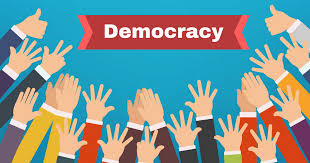Abraham Lincoln’s famous quote, “Government of the people, by the people, for the people,” is considered the simplest and most prevalent definition of democracy

Niraj Krishna
Democracy thrives on representation and accountability. Elections function as the cornerstone of this system, empowering citizens to choose representatives who reflect their aspirations and values. However, inherent flaws in electoral systems often lead to dissatisfaction among voters.
Abraham Lincoln’s famous quote, “Government of the people, by the people, for the people,” is considered the simplest and most prevalent definition of democracy. It is noteworthy that while ownership in democracy lies with the people, discontent often arises regarding the selection of their representatives.
In the grand festival of democracy, if the public does not find any candidate satisfactory yet still casts their vote, believing that choosing the lesser of two evils is the best option, it’s certainly not a good sign for democracy. Can our system not provide a candidate committed to the welfare and well-being of the people? If, under any circumstances, no suitable candidate appears, what should the people do? This question has been the subject of lengthy debates for a long time.
Standing in long lines to vote, if you cannot decide whether any of the candidates are right or not, surely indicates the hidden anger and frustration within the public. In 2009, the Election Commission informed the Supreme Court of its intention to introduce the NOTA option.
In the vast spectrum of democratic processes, the principle of “None of the Above” (NOTA) stands as a unique mechanism, allowing voters to express their dissent towards available electoral options. NOTA provides citizens with an opportunity to reject all candidates contesting elections, signaling their dissatisfaction with the prevailing choices. While NOTA appears as a symbol of democratic expression, its effectiveness as a mechanism of scrutiny and balance within the democratic framework requires thorough examination.
The purpose of NOTA is to provide an option to those voters who do not wish to vote for any candidate. It is indeed a tool to oppose the candidates contesting elections. If you do not prefer any candidate from a political party and do not want to vote for any of them, what would you do then? The Election Commission has made arrangements for this. NOTA, or none of the above, has been provided as an option to the voters in most elections in India. Through the use of NOTA, any citizen can choose not to vote for any candidate contesting an election.
It is believed that the first use of NOTA was in the United States. The use of NOTA in ballots took place for the first time in the 1976 election of the Isla Vista Municipal Advisory Council in California, USA. In Russia, this option was available to voters in 2006 but was later removed. In many countries around the world, winning with more than 50 percent of the votes is a provision for victory. In such a case, if the number of NOTA votes exceeds 50 percent, the election is canceled and a re-election is held, thus increasing the significance of NOTA.
When the Supreme Court ordered the Election Commission to introduce NOTA in EVM machines in 2013, perhaps no one could have guessed how much impact this system would have on elections. However, just a year later, during the Lok Sabha elections in 2014, the adoption of this option by nearly 60 lakh, or 1.08 percent, of voters highlighted the significance of this system.
In the past five years, approximately 1.29 crore voters chose the NOTA option during general elections and state assembly elections. According to the report, during this period, an average of 64,53,652 votes were cast under NOTA in state assembly elections, while in the Lok Sabha elections, the Gopalganj seat in Bihar saw the highest number of 51,660 voters choosing the NOTA option. Conversely, the Lakshadweep Lok Sabha seat saw the lowest, with only 100 voters opting for NOTA. According to the report, during the 2020 assembly elections, the highest percentage of 1.46 percent of voters chose the NOTA option in two states, with 7,06,252 voters in Bihar and 43,108 voters in Delhi pressing the NOTA button.
Before the introduction of NOTA, many political parties opposed it, arguing that it would create confusion among voters. However, the court directed its implementation, considering it necessary for democracy.
Since the introduction of NOTA, there have been several instances of concern and contemplation among political parties. For example, between 2013 and February 2017, in the voting that took place, NOTA received more votes than the victory margin on a total of 261 assembly and 24 Lok Sabha seats.
Notably, even in the 2017 Gujarat Assembly elections, the difference between the top two candidates who received the most votes on a total of 21 seats was less than the NOTA votes. This has increased the seriousness and gravity of political parties towards NOTA votes.
Some people are dissatisfied with the current form of NOTA, arguing that it does not give voters the right to reject candidates standing in the election. They argue that the effectiveness of NOTA can only be realized when ordinary people also have the right to reject candidates.
Although the number of NOTA votes may be low, it is being seen as a form of protest by frustrated voters against the increasing influence of money and muscle power in elections. Many civil society groups and activists are challenging political parties to choose the NOTA option in the upcoming elections, against their schemes and nominations.
The Supreme Court also believes that NOTA should only be applicable in direct elections. The court said that this option will not be applied where there is proportional representation, and introducing NOTA in Rajya Sabha elections will undermine the concept of consensus-based average assessment.
On August 21, 2018, under the chairmanship of the Chief Justice of the Supreme Court, Justices A.M. Khanwilkar and D.Y. Chandrachud’s bench pronounced an important verdict stating that NOTA (None of the Above) will not be used in Rajya Sabha elections. The Supreme Court stated in its verdict that NOTA would encourage defection and open doors for corruption. It mentioned that NOTA was introduced for direct use by voters in elections. NOTA was introduced so that individuals could use this option as voters in direct elections.
Actually, in 2013, the Supreme Court ordered to make the NOTA option mandatory in electronic voting machines (EVMs), and thereafter, a notification regarding the provision of NOTA was issued in January 2014. The Supreme Court stated in its order that just as every voter has the right to vote, they also have the right not to vote for anyone.
NOTA serves as an important tool to enhance transparency and integrity in elections. The validity of democracy depends on the consent of the governed. When a significant portion of voters choose NOTA, it highlights the importance of electoral integrity and exposes examples of candidate misconduct or electoral fraud.
The success of NOTA largely depends on voter awareness and participation. In many democracies, voter turnout has become a serious concern, discouraging indifferent citizens from exercising their voting rights. While NOTA provides an outlet for dissatisfied voters, its effectiveness as a widespread tool for effecting change depends on adoption amidst dissent.
In fact, NOTA grants the freedom to choose or not choose a preferred candidate. With the option of NOTA available to voters in India, they have the right to use their vote, which was previously denied to them due to not having a preferred candidate. Since the introduction of the NOTA option in the country, voters have been using it in elections.
While NOTA symbolizes democratic dissent and promotes accountability and transparency in electoral processes, its effectiveness as a mechanism of scrutiny and balance depends on various factors. To realize its full potential, NOTA should be coupled with improvements that enhance its impact, such as provisions for re-election or consequences for candidates in a significant NOTA vote share situation. Furthermore, efforts to increase voter awareness and active participation are essential to ensuring that NOTA functions not as a symbol of apathy but as a meaningful tool for democratic expression.
Ultimately, the role of NOTA in democracy depends not only on its indication of dissatisfaction but also on its capacity to stimulate substantial electoral reforms and political changes.
If the values of democracy are to be upheld, electoral reforms should be the first step. Indeed, if the public is dissatisfied with their representatives, they can teach them a lesson in the next elections. Elections come once every five years, so the public also has the right to call them back under ‘right to recall,’ but the problem arises when situations occur where the public feels that all candidates are incompetent, yet someone ends up reaching the parliament or legislative assembly, which does not align with the fundamental purpose of NOTA.


